The Best 18 Plants That Thrive Under Evergreen Trees
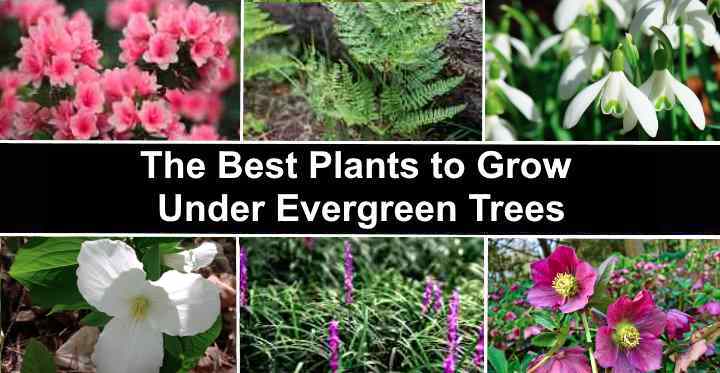
Growing plants under evergreen trees can be challenging due to the shade and dry ground. In addition, if you are planting under a coniferous tree like pine, you’ll also have acidic soil. Many types of evergreen trees have shallow roots that absorb nutrients and moisture from the shaded root zone. Therefore, various shrubs, perennials, ornamental grasses, and ground cover plants may struggle to grow under evergreen trees.
The good news is that many plants thrive in the understory of evergreen trees. Shade and drought-tolerant plants can transform the shaded area beneath evergreen trees into vibrant, lush landscapes. These shrubs and flowers don’t just survive—they thrive, enhancing the beauty of evergreen landscapes.
This article provides a list of plants for underplanting evergreen trees. Descriptions and pictures of evergreen companion plants will help you choose the best ones to grow for a beautiful and lush garden.
What to Plant Under Evergreen Trees
The best plants to grow under evergreen trees are shade-tolerant perennials and bulbs such as lenten roses, Japanese-painted ferns, and evergreen azaleas. Additionally, spring-flowering plants such as Virginia bluebells, wood lilies, barrenwort, and anemones can add vibrant color to the understory of evergreen trees.
How to Choose Plants for Growing Under Evergreen Trees
When selecting plants for growing under evergreen trees, prioritize shade-tolerant ground cover plants, perennials, and bulbous flowers that can thrive in dry, nutrient-deficient soil. It’s important to choose companion plants with shallow roots to avoid damaging the tree roots.
When landscaping an evergreen woodland understory, it’s vital to avoid planting too close to the tree roots. Thick, dense ground cover for evergreen tree areas should be two or three feet (0.6 – 1 m) from the base. This ensures the tree’s roots get enough oxygen and moisture.
The Best Plants to Grow Under Evergreen Trees
Read on to learn about the best landscaping shrubs, perennials, decorative grasses, and ferns for underplanting evergreen trees.
Lenten Roses (Helleborus orientalis)
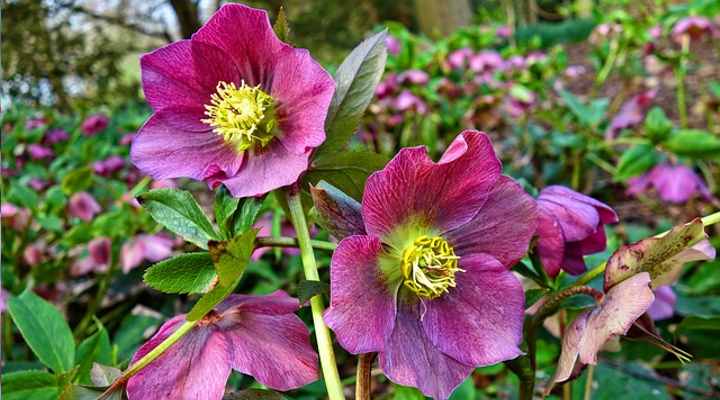
Lenten roses are popular plants for planting in the shade of pine trees and evergreens. Also called hellebore, the shade-loving perennials have large, cup-shaped flowers in white, pink, purple, green, and black-purple shades. The flowers bloom in early spring, providing a burst of color to the understory of evergreen trees.
These bushy, clumping, shade-loving perennials grow up to 2 ft. (0.6 m) and are easy to grow in evergreen woodlands. The spectacular, showy flowers contrast nicely with dark, leathery, evergreen foliage. Lenten roses also perform well in well-drained soils if they are not too wet or dry. Their long-lasting blooms make them a beautiful addition to areas under evergreen trees.
- USDA Planting Zone: 4 to 9
- Sun Exposure: Partial shade to full shade
- Blooming Season: Throughout spring
- Mature Size: 1 to 2 ft. (0.3 – 0.6 m) tall and wide
- Growth Rate: Slow growth rate, forming clumps over time
Christmas Fern (Polystichum acrostichoides)
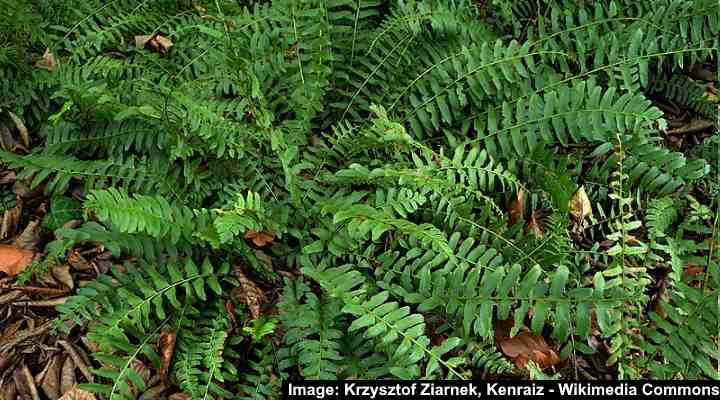
Christmas fern is a popular evergreen plant for landscaping under conifers and other evergreens. Ferns thrive in the shade and organically rich, dry soils. The lush ferns are identified by their dark green pinnate fronds with leather leaflets. In spring, silvery green foliage emerges before turning darker green shades.
Christmas ferns are low-maintenance and deer-resistant, making them an ideal choice for carpeting evergreen woodland gardens. The ground cover plants spread through creeping rhizomes, and their arching fronds create texture in shaded landscapes. Although most ferns prefer moist soils, the Christmas fern can tolerate periods of drought once established.
- USDA Planting Zone: 3 to 8
- Sun Exposure: Partial shade to full shade
- Mature Size: 1 to 2 ft. (0.3 – 0.6 m) tall and wide
- Growth Rate: Medium growth rate, forming clumps of feathery foliage over time
Japanese Painted Fern (Athyrium niponicum var. pictum)
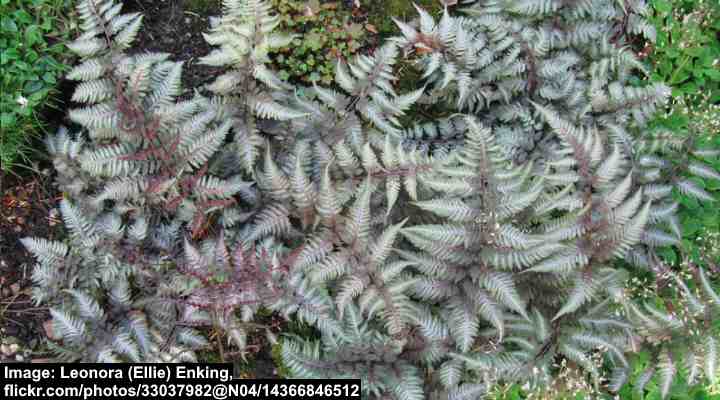
Japanese painted ferns are some of the most spectacular plants for growing in the shade of evergreen trees. This beautiful, unique fern thrives in deep shade. Its identifying characteristics are large, soft blue-green arching fronds. The lance-shaped leaves have a silvery sheen, contrasting with the dark burgundy midribs.
Deciduous Japanese painted ferns, with their striking silver, green, and burgundy foliage, create a stunning display to the understory of evergreen trees. They are one of the most drought-tolerant ferns, making them ideal for planting near tree trunks in deep shade. Easy to grow in shady beds, the ferns are resistant to rabbits and deer.
- USDA Planting Zone: 3 to 8
- Sun Exposure: Partial shade to heavy shade
- Mature Size: 1 to 2 ft. (0.3 – 0.6 m) tall and wide
- Growth Rate: Medium growth rate, forming clumps of arching leafy fronds over time
Evergreen Azaleas (Rhododendron)
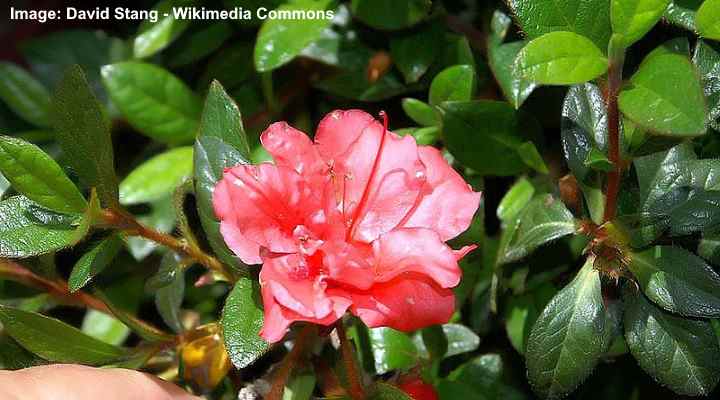
Encore azalea ‘Autumn Princess’
Evergreen azalea shrubs are ideal for planting a few feet from evergreen tree trunks. The flowering shrubs are tolerant of shade and dappled sunlight. They are drought-tolerant plants known for vibrant, trumpet-shaped blooms, green leathery lanceolate leaves, and rounded growth habit.
Encore evergreen azaleas don’t grow taller than 3 ft. (1 m) tall. The ornamental shrubs bloom in spring and rebloom in late summer or early fall. They are ideal for landscaping around an evergreen tree’s drip line, providing uninterrupted color throughout the year.
Encore azaleas thrive in well-drained, acidic soils, and their blooms attract hummingbirds and butterflies to shaded woodlands. Because they require moist soil, mulching around the shrub’s roots can help them thrive.
- USDA Planting Zone: 6 to 10
- Sun Exposure: Full sun, dappled sunlight, partial shade
- Blooming Season: Spring, then reblooming in late summer through early fall
- Mature Size: 2 to 3 ft. (0.6 – 1 m) tall and wide
- Growth Rate: Moderate growth rate with a rounded habit
Barrenwort (Epimedium spp.)
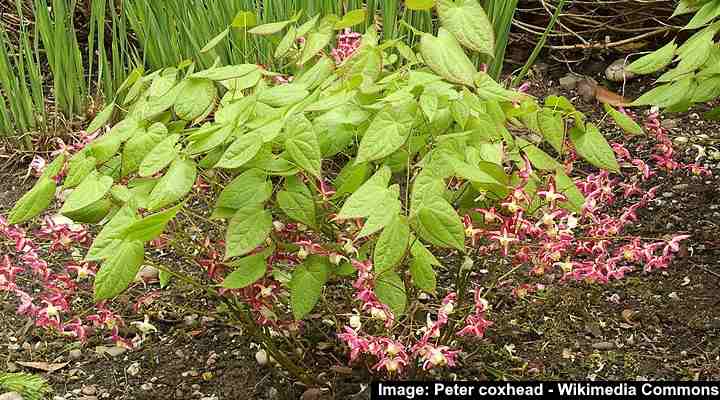
In the picture: Red barrenwort (Epimedium × rubrum)
Barrenwort is a group of perennials that thrive under evergreen trees due to their shade tolerance and beautiful sprays of flowers. The low-growing ground cover plants have heart-shaped leaves and delicate, colorful flowers with wiry stamens. This ornamental bushy plant performs exceptionally well under the heavy shade of mature evergreen trees.
Barrenwort plants are drought-resistant, require minimal maintenance, and spread to form a lush ground cover in dry, shaded environments. The long-blooming perennials are ideal for dry, acidic soil, creating color and texture in the understory of evergreen woodlands. Over time, they spread to create attractive purple, yellow, pink, and lilac flower colonies.
- USDA Planting Zone: 4 to 8
- Sun Exposure: Dappled sunlight, partial shade, and deep shade
- Blooming Season: From mid-spring for several weeks
- Mature Size: 8” to 24” (20 – 60 cm) tall and wide
- Growth Rate: Slow-growing, taking 12 months to become established
Crested Iris (Iris cristata)
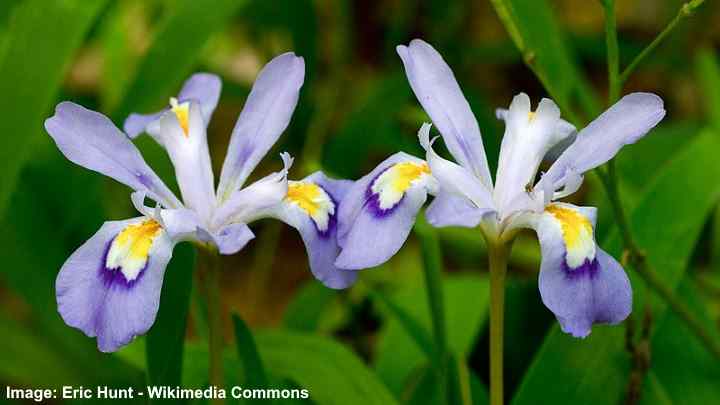
Crested iris is a fast-growing spreading plant well-suited for under evergreen trees due to its adaptability to shade and dry conditions. The perennial plant’s outstanding ornamental features are its attractive blue or purple flowers with crested petals, glossy, dark green leaves, and mat-forming habit in woodland understories.
Crested iris flowers bloom in spring in dry shade. They don’t grow taller than one foot (0.3 m). The beautiful purple flowers with white and gold markings add color and lush foliage over the ground in shaded landscapes. Native to the southeastern United States, crested iris spread by underground rhizomes. It is also deer-resistant and attracts pollinators like bees and butterflies.
- USDA Planting Zone: 4 to 10
- Sun Exposure: Light shade to partial shade
- Blooming Season: Early to mid-spring
- Mature Size: 6” to 12” (15 – 30 cm) tall and wide
- Growth Rate: Fast growth rate, forming a dense ground cover over time
Virginia Bluebells (Mertensia virginica)
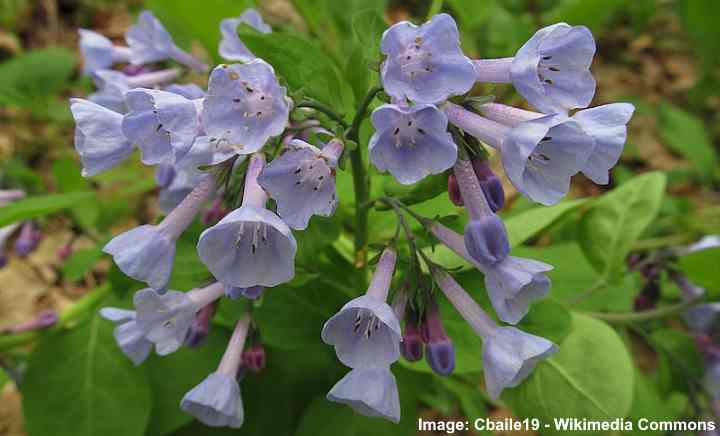
Virginia bluebells are early spring blooming plants, perfect for adding color to the shaded areas around evergreen trees. These native spring ephemerals have clusters of bell-shaped, sky-blue or purple flowers and smooth, oval leaves 4” (10 cm) long. The long-lasting pale blue or lilac blooms emerge from pink buds and grow in clusters at the end of leafy stems.
Virginia bluebells grow well in part shade to full shade in moist soil. Therefore, depending on rainfall and proximity to the drip line, you may need to mulch around them to keep the soil moist. Native Virginia bluebell flowers attract butterflies and bees, making them a beneficial addition to any shaded garden landscape.
- USDA Planting Zone: 3 to 8
- Sun Exposure: Partial sun to heavy shade
- Blooming Season: Early to mid-spring
- Mature Size: 1 to 2 ft. (0.3 – 0.6 m) tall and wide
- Growth Rate: Moderate growth rate, forming clumps over time
Hakone Grass (Hakonechloa macra)
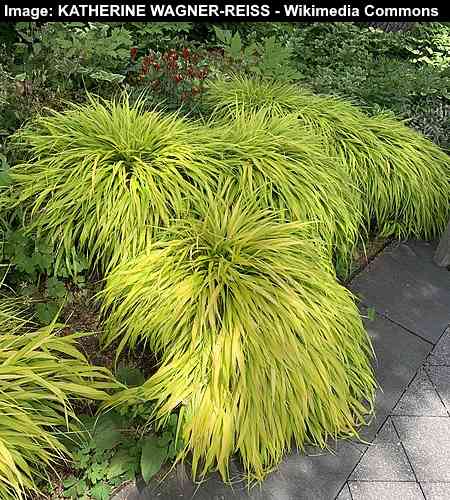
Hakonechloa macra ‘All Gold’
Hakone grass is a beautiful ornamental grass ideal for growing under evergreen trees in shady conditions. This clump-forming grass grows up to 2 ft. (0.6 m) tall with arching, cascading leaves. These create a flowing, soft texture in a woodland understory, adding a vibrant pop of bright green color to shady areas.
Unlike many ornamental grasses, hakone grass is tolerant of heavy shade. It also prefers moist, well-drained soil and can tolerate a range of soil types. Therefore, mulching around the plant’s base may be necessary when growing under evergreen trees. This grass is also deer-resistant and low-maintenance, perfect for adding visual interest under evergreens without much effort.
- USDA Planting Zone: 5 to 9
- Sun Exposure: Full sun, partial shade, full shade
- Mature Size: 1 to 2 ft. (0.3 – 0.6 m) tall and wide
- Growth Rate: Slow spreading growth, forming clumps of arching, linear green leaves
Hostas (Hosta)
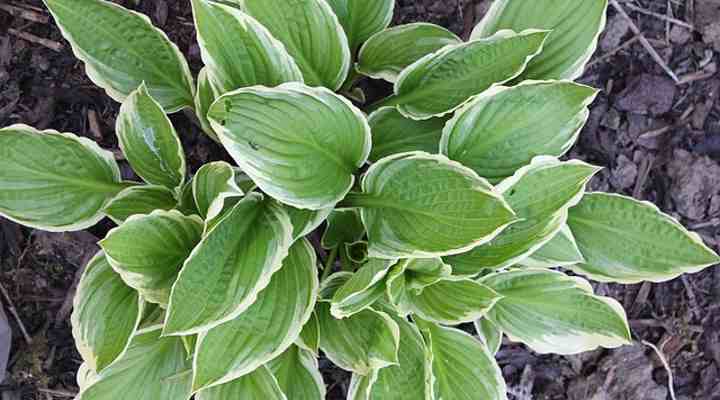
Hostas are excellent perennial plants for growing under evergreen trees due to their shade-loving nature and tolerance of dappled sunlight. Their lush foliage and variety of leaf colors add texture and interest to shaded areas. Hostas planted under evergreen trees benefit from regular watering, especially during dry periods, to maintain consistent soil moisture.
While hostas are not primarily known for their flowers, they produce elegant blooms during the summer, adding to the visual appeal of the area. With their diverse foliage in various shades and patterns, hostas create an attractive and low-maintenance understory beneath evergreen trees.
- USDA Planting Zone: 3 to 9
- Sun Exposure: They prefer partial to full shade, making them well-suited for growing under the canopy of evergreen trees
- Mature Size: Hostas can vary in size, with miniature varieties reaching about 6 inches in height and larger cultivars growing up to 2 feet tall and wide
- Growth Rate: Moderate growth rate, forming lush clumps over time in the shaded environments under evergreen trees
Wood Anemone (Anemone quinquefolia)
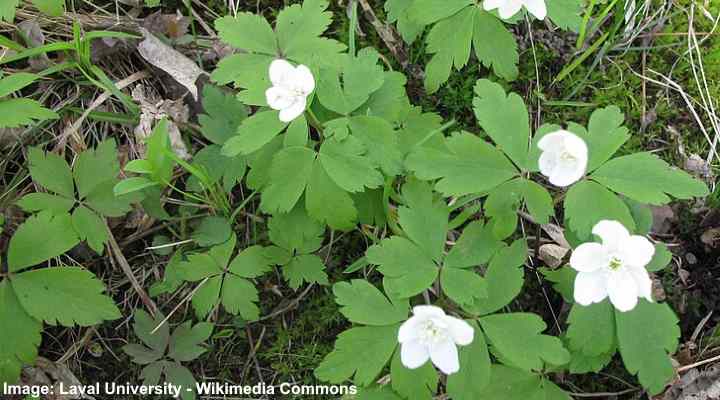
Wood anemone is a lovely shade-loving perennial that thrives under evergreen trees. It blooms in early spring, displaying five-petaled white flowers and deeply divided, fern-like leaves. Wood anemone flowers have delicate pink veining and are perfectly suited for the shade of evergreen trees. Their slender, leafy stalks gently sway in the breeze, earning them the nickname ‘wind flowers.’
Wood anemones are native shade perennials that thrive in well-drained, acidic soil and prefer partial to full shade. They make an excellent choice for the understory of evergreen trees. The delightful combination of their white flowers and deep green foliage adds to the beauty of the area surrounding evergreen trees.
These charming wood anemone flowers thrive best in shady woodland edges or when planted near the tree’s drip line. Their low-growing, clumping nature also attracts pollinators like bees and butterflies.
- USDA Planting Zone: 5 to 8
- Sun Exposure: Partial shade to full shade
- Blooming Season: Early spring to early summer
- Mature Size: 6” to 10” (15 – 25 cm) tall and spreads to form colorful colonies
- Growth Rate: Slowly spreads over time
Bleeding Heart (Dicentra spectabilis)
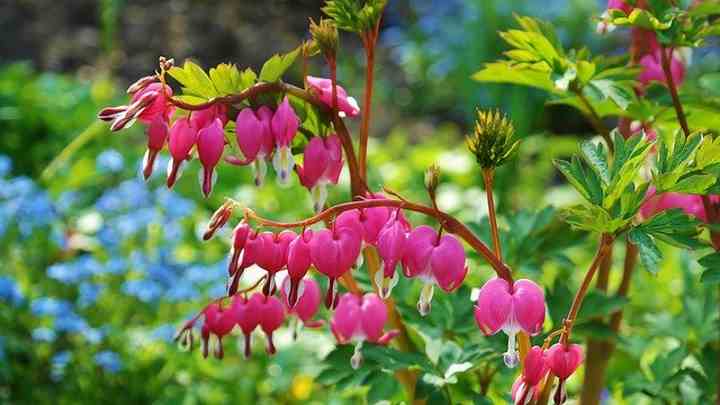
Bleeding heart plants are eye-catching flowering perennials that thrive under evergreen trees. Identifying features of the evergreen companion plant are the heart-shaped flowers on arching stems and soft green divided leaves. The delicate flowers bloom in spring and summer, adding a pop of color to woodland gardens.
Bleeding hearts prefer partial shade and moist, well-drained soil. They tolerate heavy woodland shade but will produce fewer flowers. The pink-flowering shrubby perennial tolerates deer, rabbits, and heavy shade. The flowers also attract hummingbirds and pollinators to gardens.
- USDA Planting Zone: 3 to 9
- Sun Exposure: Partial shade to full shade
- Blooming Season: Spring to early summer
- Mature Size: 2 to 3 ft. (0.6 – 0.9 m) tall and wide
- Growth Rate: Moderate growth rate, forming a bushy mound
Wood Lily (Trillium)
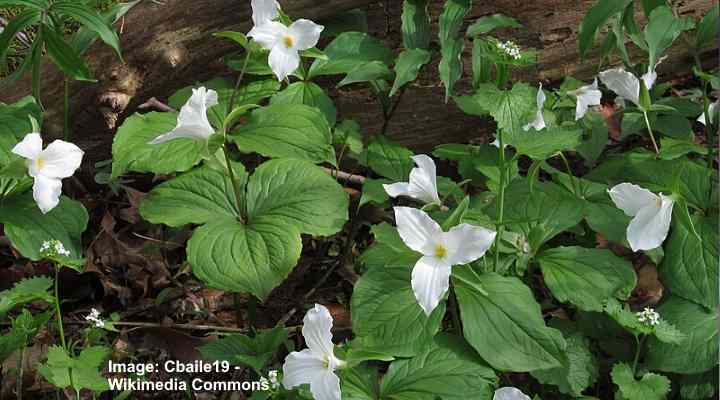
White trillium (Trillium grandiflorum)
Wood lilies add a touch of elegance growing under evergreen trees due to their attractive flowers and shade tolerance. The eye-catching spring ephemeral flowers bloom in white, pink, red, yellow, and orange shades. The flowers have three pointed petals and broadly ovate leaves. They thrive naturally under the canopy of large evergreen trees.
- USDA Planting Zone: 4 to 8
- Sun Exposure: Partial shade to full shade
- Blooming Season: Early spring to early summer
- Mature Size: Up to 2 ft. (0.6 m) tall and wide
- Growth Rate: Slow growth rate, forming clumps over time
Woodland Crocus (Crocus tommasinianus)
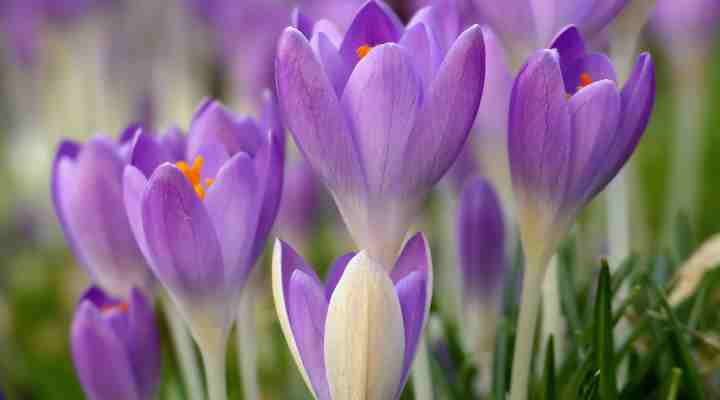
Also called snow crocus, this beautiful spring-blooming bulb thrives in the shade edges of evergreen tree canopies. This bulbous flowering plant has cup-shaped flowers with six petals in purple, lavender, and white shades. The flowers emerge before the strappy green leaves, creating a stunning floral on a woodland floor.
Woodland crocus is an excellent plant for naturalizing under deciduous and evergreen trees. The bulbs spread easily, forming a colorful carpet of spring flowers. They also add a touch of early-season color to woodland gardens, attracting pollinators like bees and butterflies.
- USDA Planting Zone: 3 to 8
- Sun Exposure: Full sun to partial shade
- Blooming Season: Early spring
- Mature Size: 4” to 6” (10 – 15 cm) tall and wide
- Growth Rate: Moderate spreads through underground rhizomes and reseeding
Grape Hyacinth (Muscari armeniacum)
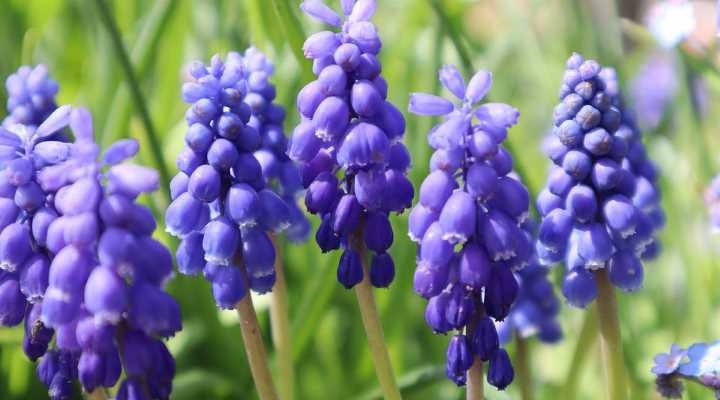
Grape hyacinth is a vibrant understory plant for growing near evergreen trees. The spring-blooming bulbs produce conical clusters of small, grape-like flowers. The bell-shaped flowers are usually cobalt blue but can also be purple, pink or white. Grass-like foliage surrounds the blue-flowering spikes. The flowers and grassy foliage add texture and interest to the landscape.
Grape hyacinth thrives in partially shaded landscapes under evergreen trees. Growing in mass plantings, the stunning purple-blue flowers create a mat of color. They thrive in average moisture soils and are deer and rabbit-resistant.
- USDA Planting Zone: 4 to 8
- Sun Exposure: Full sun to partial shade
- Blooming Season: Spring
- Mature Size: 6” to 8” (15 – 20 cm) tall
- Growth Rate: Moderate growth rate, naturalizing over time without becoming invasive
Snowdrops (Galanthus)

Common snowdrops (Galanthus nivalis)
Snowdrops are one of the first spring flowers to bloom under the shade of evergreen trees. The delicate, nodding white bell-shaped flowers bloom at the end of slender, erect stems surrounded by shorter, narrow leaves. Snowdrops often emerge through the snow, symbolizing the arrival of spring.
Not growing more than a foot (30 cm) tall, snowdrops are perfect for brightening the understory of evergreen trees. They thrive in well-drained soils and partial shade—ideal for dappled shade in woodland gardens. These low-growing plants form clumps and multiply over time, creating a beautiful carpet of white spring blooms.
Snowdrops only require planting 3” (7.5 cm) deep. Therefore, you don’t risk damaging tree roots when planting them several feet from the tree trunk.
- USDA Planting Zone: 3 to 9
- Sun Exposure: Full sun, dappled sunlight, or partial shade
- Blooming Season: Late winter to early spring
- Mature Size: 4 to 6 inches (10 – 15 cm) tall
- Growth Rate: Slowly spreads, naturalizing over time to form larger groups
Canada Wild Ginger (Asarum canadense)
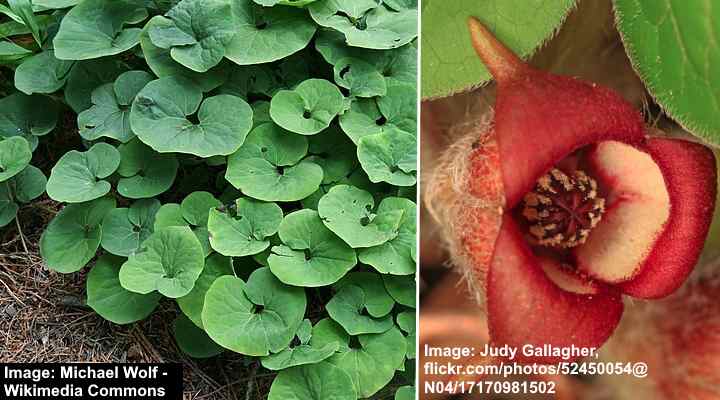
Canada wild ginger is an easy-grow deciduous ground cover plant that thrives in evergreen woodland gardens. Ornamental features of the low-growing plant are its heart-shaped, dark green leaves and bell-shaped reddish-brown flowers growing close to the ground. Canada wild ginger blooms in spring, which is ideal for adding color and texture when underplanting evergreen trees.
Canada wild ginger is an excellent evergreen tree companion plant that does not grow more than a foot (0.3 m) tall. It spreads slowly through rhizomes, forming a dense carpet-like ground cover. The plant’s roots have a pleasant ginger taste, and its leaves are deer-resistant.
- USDA Planting Zone: 4 to 6
- Sun Exposure: Full shade to partial shade
- Blooming Season: Spring
- Mature Size: 6” to 12” (15 – 30 cm) tall and p to 2 ft. (60 cm) wide
- Growth Rate: Slow growth rate, forming a dense ground cover over time
Sweet Woodruff (Galium odoratum)

Sweet woodruff is a white-flowering ground cover plant that thrives under dense evergreen trees. The mat-forming perennial’s features are tiny white, star-shaped flowers, whorled, lance-shaped leaves, and sweet floral scents. The full-shade plant grows easily in average, moist soils. The spreading plant adds texture and fragrance to evergreen woodlands.
Sweet woodruff prefers slightly acidic soil, is easy to grow, suppresses weeds and creates a natural carpet in shady areas.
- USDA Planting Zone: 4 to 8
- Sun Exposure: Partial shade to full shade
- Blooming Season: Late spring to early summer
- Mature Size: 5” to 6” (13 – 15 cm) tall and spreading up to 12” (30 cm) wide
- Growth Rate: Moderate growth rate, spreading through rhizomes
Lily Turf (Monkey Grass) (Liriope muscari)

Liriope muscari grass on the left and variegated type on the right (Liriope muscari ‘Variegata’)
Lily turf—or monkey grass—produces dense violet-purple or pink flowers in shaded woodland edges. Planted in mass, the tuberous perennial produces clumps of evergreen grass-like leaves and clustered spikes of small, bell-shaped purple or pink flowers in late summer. It is a low-maintenance plant that adds texture and color to areas around evergreen trees.
Lily turf performs best in acidic soils in partial shade. However, it can tolerate periods of dry soil once established. It can also grow in full shade; however, its flowering stems become leggy, and growth slows. Additionally, monkey grass tolerates deer, rabbits, heat, drought, and humidity.
- USDA Planting Zone: 5 to 10
- Sun Exposure: Full sun, partial shade, full shade
- Blooming Season: Late summer through early winter
- Mature Size: 1 to 2 ft. (0.3 – 0.6 m) tall and wide
- Growth Rate: Slow to moderate growth rate, forming dense clumps over time
The Essentials of Landscaping Under Evergreen Trees
To create a thriving garden beneath evergreen trees, trim lower branches to allow sufficient light, avoid building raised beds that may harm the tree roots, and plant in separate holes to prevent root disturbance. Opt for small plants, water new plants adequately, and be mindful of the tree roots during planting to minimize any damage. Selecting the right plants, such as azaleas, woodland sunflowers, hostas, Jacob’s ladder, lily of the valley, and ivory sedge, can contribute to a flourishing landscape under evergreen trees.
Trim Away Lower Branches of Your Evergreen Trees
Trimming a few of the lower branches of the tree opens up space for planting and allows vital light to filter through. Even shade-tolerant plants need some light for their survival.
Avoid Building Raised Beds Under Trees
Building a raised bed around the base of a tree might seem like a good idea to improve soil quality for your plants. However, this can harm or even kill the tree. Trees typically have surface roots that require oxygen to survive. Piling up compost, soil, and mulch around the tree suffocates these roots, leading to decay. Instead, it’s best to work with the existing soil.
Plant in Holes To Prevent a Disturbance to the Tree Roots
When planting under trees, give each plant its own hole. This approach prevents damage to the tree’s shallow root system. Fill each hole with composted organic matter to benefit the plants. Apply a thin layer of mulch, no more than 3 inches (8 cm), around the base of the tree and plants.
Plant Small Plants
Large and spreading plants can quickly overwhelm a garden under a tree, competing for space and light. Opt for small, low-growing plants to ensure the best results. This choice will also allow other smaller plants to thrive.
Water New Plants Adequately
Newly planted flowers may struggle to access water, especially when competing with the tree’s roots. For the first few weeks after planting, water your flowers daily on non-rainy days to help them establish their roots.
Avoid Damaging Tree Roots
When digging holes for your plants, take care not to damage the tree’s roots. Make holes for small plants just large enough to accommodate them without disturbing the tree’s roots. If you encounter significant tree roots, refill the hole and choose a different location to plant. It’s crucial to minimize root disturbance to preserve the tree’s health.
Select the Right Plants For Landscaping Under Evergreen Trees
Choose plants that are well-suited for growing under trees. Some of the plants that do well under evergreen trees are azaleas, woodland sunflowers, hostas, Jacob’s ladder, lily of the valley, and ivory sedge.
Related articles:
